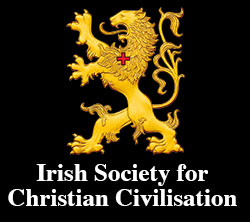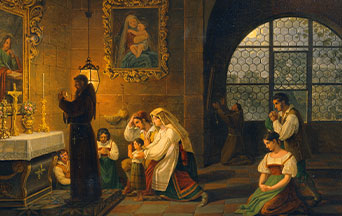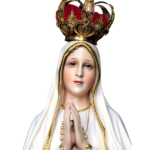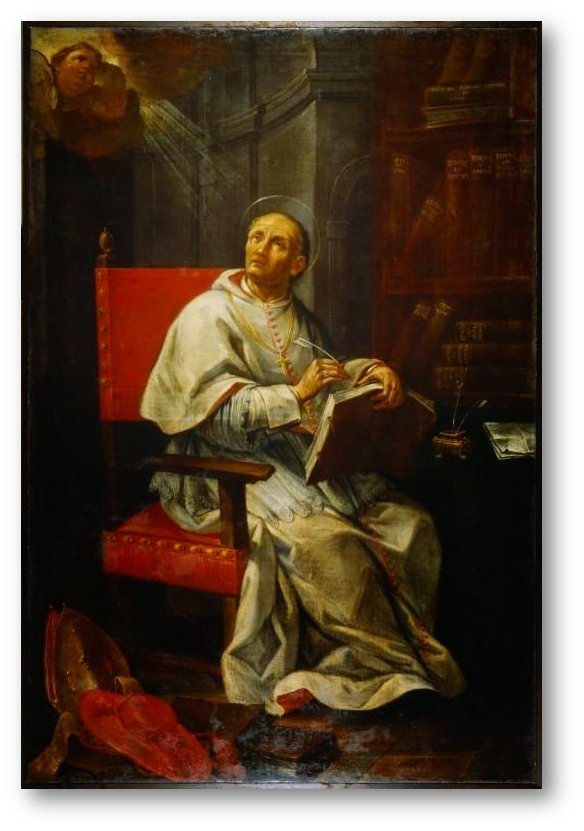
“Let us faithfully transmit to posterity the example of virtue which we have received from our forefathers.”The Doctors of the Church are saints who are honoured with this title because of their great learning in setting forth the Christian teaching and in defending it against heretics and the spirit of the age. The Church recognises the special graces and Divine lights they receive and honour them with the title Doctor of the Church. St. Peter Damian was one such person who was recognised. He is one of those stern figures who seem specially raised up, like St. John Baptist, to recall men in a lax age from the error of their ways and to bring them back into the narrow path of virtue. As a Benedictine monk he strove for the reform of religious life and the correction of abuses.
St Peter Damian was born (1007A.D.) in Ravenna, Italy. The youngest of a large family his parents died when he was still very young, leaving him orphan, he was at first adopted by an elder brother, who ill-treated and under-fed him. As a child St Peter Damian showed signs of great piety and of remarkable intellectual gifts, and he was later adopted by his older brother called Damian who was archpriest at Ravenna, had pity on him and took him away to be educated. Peter took the name Damian after this brother in grateful recognition of his kindness. St Peter Damian made rapid progress in his studies, of Theology, first at Ravenna, then at Faenza, finally at the University of Parma, and when about twenty-five years old was already a famous teacher at Parma and Ravenna. But, though even then much given to fasting and to other mortifications, he could not endure the scandals and distractions of university life and decided to retire from the world. While meditating on his resolution he encountered two hermits of Fonte-Avellana, was charmed with their spirituality and detachment, and desired to join them. Encouraged by them St. Peter Damien, after a forty days’ retreat in a small cell, left his friends secretly and made his way to the hermitage of Fonte-Avellana. Here he was received, into the Camaldolses Benedictines and, to his surprise, clothed at once with the monastic habit. In 1043 the abbot of Fonte-Avellana died. Though reluctant to do so, he became abbot of the hermitage. He guided his holy brothers with great piety, and eventually founded five other hermitages. He was kind to his monks and compassionate towards the genuinely repentant, but he also urged reform both of wandering monks and the clergy.
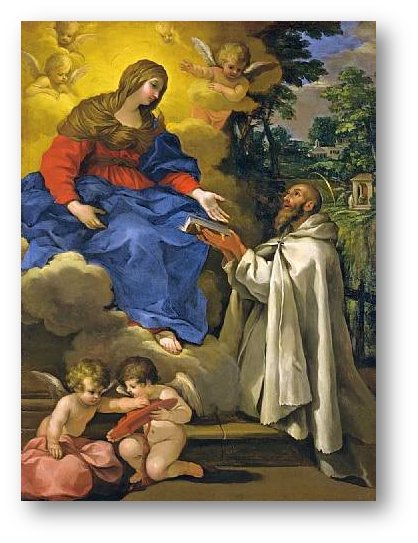
Fasting and prayer were the great hallmarks of his sanctity. He had a great love for those less fortunate than himself, and frequently dined with the poor at his table, serving them with his own hands. Especially devoted to Our Blessed Mother, St Peter Damian wrote about the Blessed Virgin, as well as composed many prayers to her grace. St Alphonsus de Liguori, summarising some of St Peter Damian’s commentary on the Blessed Virgin, as well as a prayer to Mary penned by St Peter Damian writes “that by the prayers of Mary, who stood between the cross of the good thief and that of her Son, the thief was converted and saved, and thereby she repaid a former service.” For, as other authors also relate, this thief had been kind to Jesus and Mary on their journey to Egypt; and this same office the Blessed Virgin has ever continued, and still continues, to perform. St Peter Damian’s wisdom was valued greatly within the Church, and in time, he was asked by Pope Stephen IX to be Cardinal-Bishop of Ostia on account of his learning and high virtues. Known for his writings and preaching He undertook many missions to help the Popes of his day. He rendered immense services to St Gregory VII in his struggle for the rights of the Church. He reluctantly accepted, but often asked to be reinstated as a simple monk. The Hildebrandine reform in the Church the stress for clerical celibacy and the fight against simony is largely due to St. Peter Damian. Never officially canonised, he was made a doctor of the Church by Pope Leo XII in 1828. Saint Peter is remembered for a life of penance and austerity, and preached rigorous reform. He was a man of integrity and zeal for the Lord, who confronted immorality and dishonesty wherever he found it beginning within the Church ranks among the clergy. His writings remain instrumental in clarifying Church doctrine on issues such as Purgatory, the Eucharist, the Sacraments, and Christian virtues. Eventually his wish was granted, and he returned to his simple life as a hermit, though he continued to assist the Church in matters of importance. He got an acute attack of fever and on the eighth day of this illness, while the monks were reciting the Divine Office of Matins round about him he died at Faenza in the year of our Lord 1072. His body later found to be incorrupt was buried in the church of Santa Maria Foris Portam (now known as Santa Maria Vecchia). Later his relics were translated to the cathedral of Faenza, where they are still venerated today. St Peter Damian lived the rule of St. Benedict completely: “Do not prefer anything to the love of Christ.” Saint Peter Damian wrote the following words for those who visit his tomb: “I was in the world what you are now, you’ll be what I am now: not believe the things you see will perish; frivolous are signs that precede the truth, are followed by brief moments of eternity.
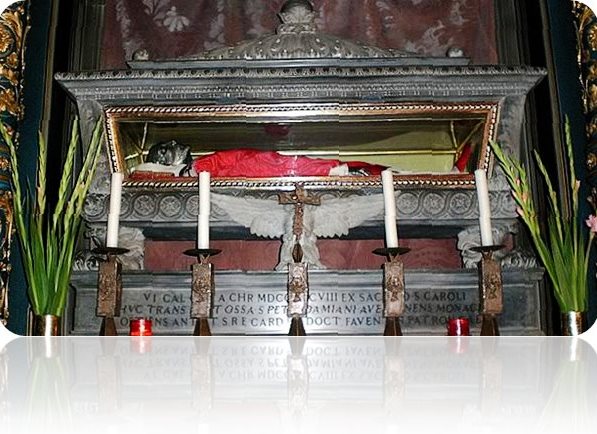
Loud thinking about death because you can live forever. All that is past, present, but what remains is approaching. As one who has done so far left, or wicked world,
who died before the meat with the body than with the meat in the world! Prefer to heavenly things earthly to the eternal deciduous. The free soul back to its beginning; the spirit to rise up and come back to that source which led, look down below him that forces him down. Remember me, I beg of you; look at the pitiful ashes of Peter; with prayers and cries of “Lord, forgive him” Interesting that after this appeared upon his tomb the sentiments of these words are found on tombs across the Catholic world on Canterbury tomb of Edward the Black Prince (1330-1276) and in art in the church of Sta. Maria Novella, in Florence, contains a fresco by Masaccio, “The Trinity” (ca. 1427). In Ireland a famous poem and saying contains the sentiments of the poem: ‘Remember Man as you go by As you are now so once was I As I am now so shall you be, Prepare yourself to follow me’ How beautifully our Catholic faith informs us in life and in death, in art and in poetry. But must important is how good God is in raising up Saints like St Peter Damian to correct us from error and to bring us back unto the narrow path of virtue. Grant, we beseech Thee, Almighty God, that by following the teaching and example of Thy blessed Confessor Peter, we may despise the goods of this world and so win for our selves eternal joys. Through our Lord Jesus Christ, Thy Son, who lives and reigns with Thee in the unity of the Holy Spirit, God, forever and ever. Amen.
This year, it is more crucial than ever that we turn to prayer and intercession to increase devotion to Our Lady across our country. That’s why you’re invited to join us in the Three Hail Marys Pledge, a powerful devotion that can bring personal spiritual benefits and national transformation. By reciting three Hail Marys daily, you honour the Immaculate Heart of Mary and seek her intercession for the conversion of sinners, the salvation of souls and the restoration of Ireland’s Catholic Faith. This ancient devotion, revealed to Saint Mechtilde, promises spiritual benefits including protection from mortal sin and the assurance of a good death. Your daily prayers will contribute to an increase in devotion to Our Lady, the conversion of sinners and the moral renewal of our country. Let us commit to this powerful devotion and seek the guidance and protection of Our Lady.


